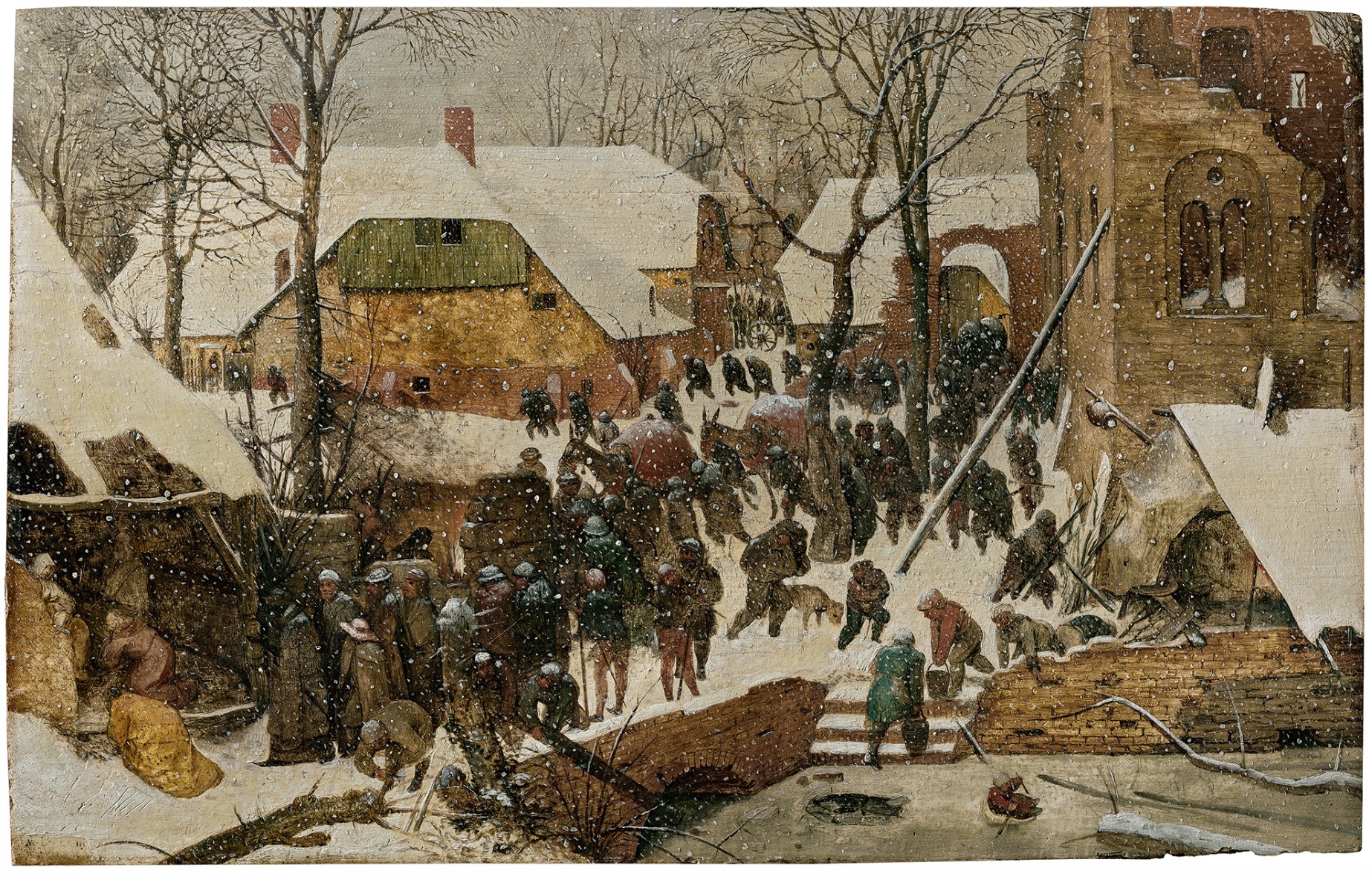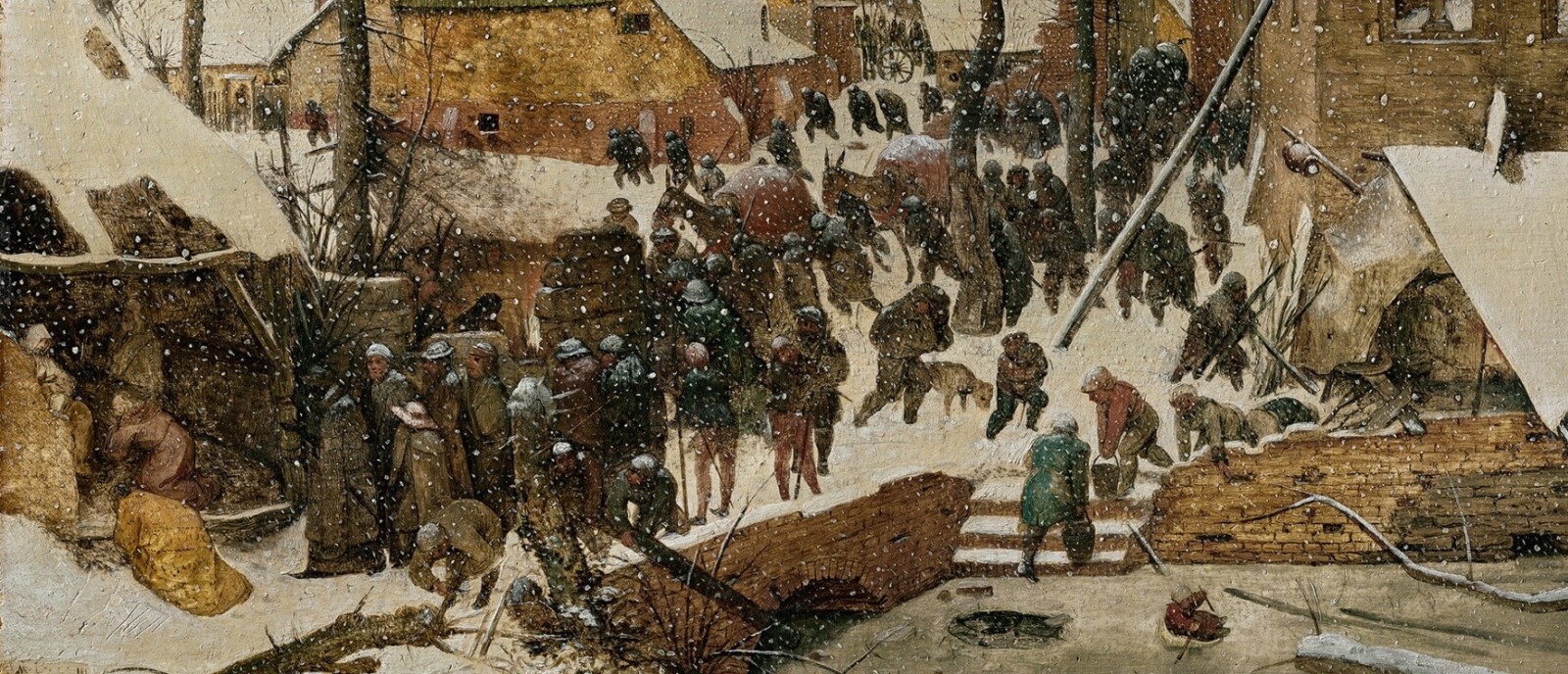And she gave birth to her firstborn son and wrapped him in bands of cloth, and laid him in a manger, because there was no place for them in the inn.
Luke 2:7 NRSV
I write this in Scotland, in January. Through a window I watch whirling hailstones catch in the grass, slowly covering and whitening the ground outside, and then start to dissolve in the weak sun, returning to clear water.
I am preoccupied by the knowledge that I have missed something: a great convocation of paintings, the Bruegel exhibition in Vienna, this winter just passed. There was not enough time. I was too busy. I had other things to do. The museum’s marketing promised things never seen before—never in this constellation—and never to be seen again. “Once-in-a-lifetime.” I looked at flights. I checked the hotels. I consulted my calendar. But I didn’t go. The ordinary demands of everyday life won out.
Those who made the journey registered online and paid their fees. They were allotted time slots to visit each day, time to stand in adoration or to follow custom, filing by, dutifully reading labels, stopping at the gift shop. Well before it was over, well before Christmas, Bruegel sold out, sealing my decision not to go. The exhibition had no room for me, and I had no time for it. By the feast of Epiphany, my schedule was filling with the new year’s business anyway. A week later the exhibition closed. The canvases were packed and returned to their homes. I never left mine.
If I had had more time, my flight to Austria would really have been to see just one painting. It is relatively obscure, relatively small, relatively marginal, but it is what I would (if I had time) cross a continent for: The Adoration of the Kings in the Snow (Epiphany).1

The painting I have not seen looks like this: a provincial Netherlandish town is blanketed in white. Fat snowflakes are falling on sturdy rustic homes and dilapidated ruins alike. People are coming home, going out. Others loiter, leaning on staffs or hard lances. Hunched against the winter, most are busy with their daily tasks and the challenges of the hostile season. Someone draws icy water from a half-frozen pond. A small, foolhardy child scuds across its surface in a rudimentary toy boat. Fires have been lit and more fuel is being gathered. Men trudge under heavy burdens, faithful dogs by their side.
Almost no one notices the small family. They are there in a murky corner at the very far, lower left-hand edge of Bruegel’s painting. A man, a young woman, and a tiny, swaddled baby, indistinct, not quite overcome by the darkness. They have found a rickety shelter, an uncertain refuge. The locals are paying little attention as the snowfall accumulates, but a few figures, different from the rest, have stopped. They look like strangers from far away, their mules laden with baggage. For this they have come. To offer gifts, to kneel, and to see.
Time passes. I am at my desk at the window again. It’s a new day, and the hail has melted away. There is a brighter light on the horizon this morning, milky clouds lit by an unseen pale sun. On my computer screen, I search the play of light and dark in a high-res photograph of Bruegel’s painting. Snow falling, snow settled, snow that has turned the world into its own negative image. The busy bodies stand out, legs driven into the snow, backs bent to their work, all darkly illuminated in reverse against the off-white ground with its scattered hues of flesh and earth. A light dusting of snow has gathered on their covered heads—these are not people who look up into snowy skies.
I search for the source of light in this world. The sky Bruegel has studied is muted, dimmer than the fallen snow. There is no clear sun, there is no bright star. The original “light that illumines,” what the philosophers call lux, is obscure. But the snow that has fallen makes all into lumen, “the light that has settled on things.”2
The Bruegel I have not seen makes light out of matter and matter into light. To really tell us about snow, the painter has to make paint do what snow does: obscure as well as reveal. With hundreds of dots of white, he veils his own hard-worked, created vision of the world. It is an effacement so radical that it has reminded some art historians, alert to this conflict-ridden time, of the iconoclasts’ whitewash.3
I think about what is obscured. I wonder about the light that has settled on things, the lumen, and how this is what reveals the people’s living and moving and being. Their sixteenth-century winter reminds me of the white noise of my twenty-first-century life, the perpetual business of all seasons. I have missed that one-time chance to travel, to stop, to see, in the flesh. Snow, swaddling. But over these days, this painting, with its parenthetical Epiphany, has become on this screen, before this window, more present and more real to me than any other I have never seen.
- The painting is currently the focus of a special exhibition: The Miracle in the Snow—Pieter Bruegel the Elder in the Oskar Reinhart Collection “Am Römerholz,” November 23, 2019 to March 1, 2020, https://www.roemerholz.ch/sor/en/home.html
- These phrases come from a discussion of lux and lumen in the concluding passage of Jean-Luc Nancy, “Art Today,” Journal of Visual Culture 9, no. 1 (2010): 91–99. Nancy talks about making art as a process of going from lumen to lux. In a sense, I wonder about Bruegel doing this, too, but in reverse, from lux to lumen.
- For more on this allusion to the Calvinist destruction of art during the Reformation era, see Joseph Leo Koerner, Bosch and Bruegel: From Enemy Painting to Everyday Life (Princeton, NJ: Princeton University Press, 2017), 286–87.
